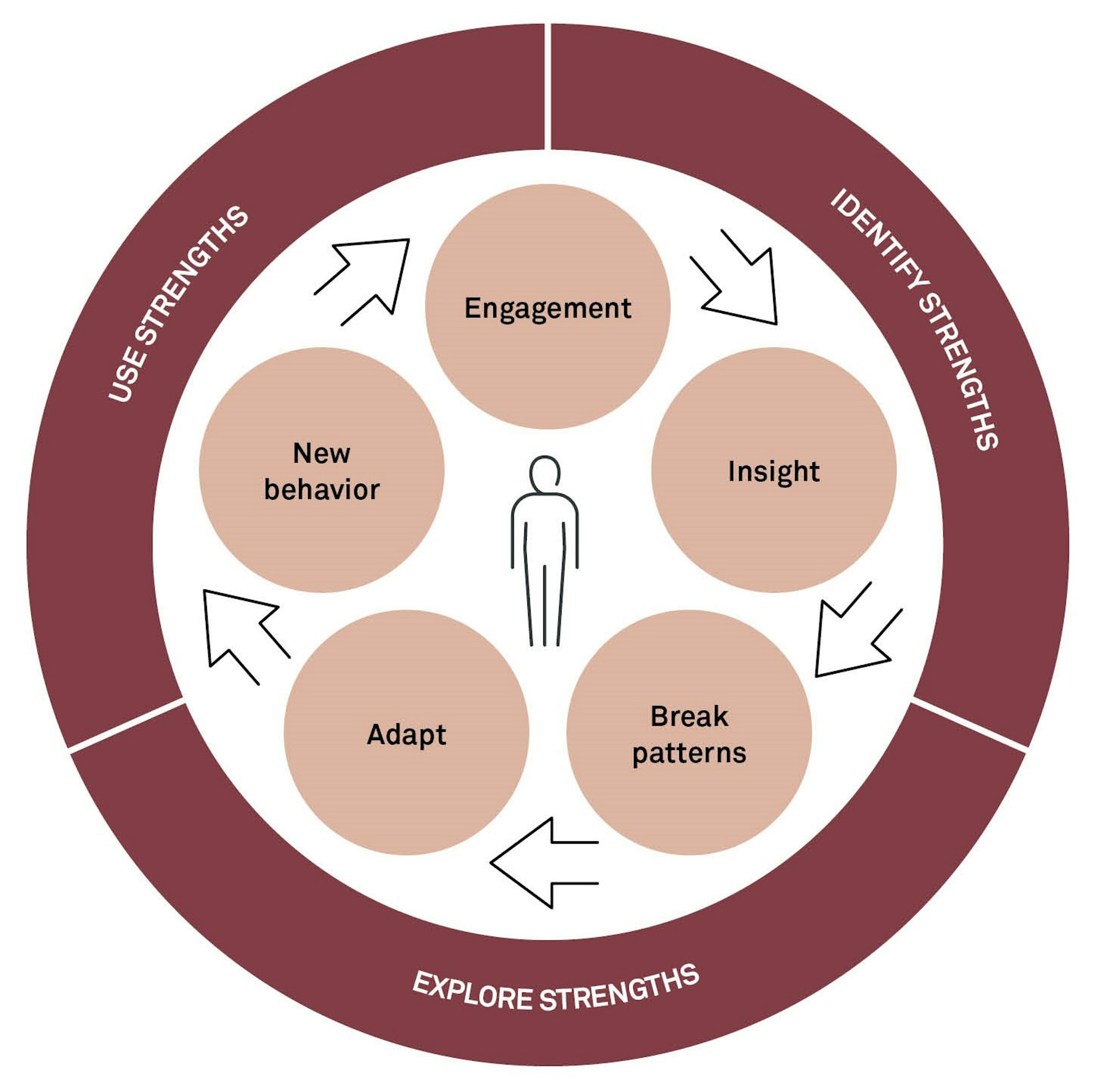Strength-based leadership
12 December 2016
In your role as a leader, you may have found yourself in the middle of a change process where you considered whether the change would ever take place. Maybe you thought that you had ensured a good level of communication, involvement and support to your employees, but they still ended up doing exactly what they always did. In this situation, you might have thought: Resistance to change! Our aim is to guide you in a different direction towards a mindset of strength-based change leadership.
As management consultants, we have in-depth experience with leadership development and design of development programmes to ensure implementation of a company’s overall strategies. Programmes that require a closer look at the structure and culture of the company as well as a deep dive into the behavioural dimensions, where we will further examine the change of habits and routines that need to take place in order to create impact. The fact is that change starts and ends with the people involved! That’s not very easy, you might think. This is why we would like to show you how you in your role as a leader can create behavioural change by working with strength-based leadership and by using neuropsychological leadership methodologies on a daily basis.
A study shows that the chance of creating engagement increases dramatically by up to as much as 73%, if you focus on the strengths of the employees. Potentially, it could also boost the overall engagement and productivity of the organisation (Rath & Conchie, 2008). Change requires engagement. Thus, it makes sense to optimise the strengths and talent of the employees during the process rather than focusing on resistance and unwanted behaviour.
Habits: How are they formed, and how can we change them?
Habits are behavioural patterns that have turned into an automatic routine through repetition. When our behaviour has a positive outcome, the neurotransmitter dopamine, which is a hormone associated with the feeling of happiness, is released, resulting in an increase in the likelihood of a repetition of the behaviour. At a neuropsychological level, habits activate neurons which fire together in certain patterns. When the habit is formed, this pattern becomes clearer, and the neurons fire together in the brain in an increasingly synchronous way. Gradually, our behaviour becomes more automated and requires less energy. This is pretty clever, because it means that we can focus our mental energy on something else!
However, it requires an enormous amount of energy to break the established habit pattern. Here, you as a change leader compete with the neurological system of the body. Realising employees’ potential of strength provides an initial advantage, as it creates the energy necessary to break old habits and move towards the formation of new patterns at the individual level.
Strength-based change leadership
In order to simplify the process, we have developed a model Circle of Change that you can apply directly to your change activities as an activity wheel, a tool for reflection or as a dialogue model.
In the outer circle, the strength-based leadership process is shown clockwise. The trick is not only to identify and use strengths but to examine whether the strengths are overplayed or underplayed (Biswas-Diener, Kashdan & Minhas, 2011). That’s why, in collaboration with each employee, you should examine what gives him/her energy, what he/she does best, and how this particular strength or other strengths can be adapted to different situations. Less developed strengths should also be brought into use, if the situation requires it. Subsequently, you should agree on how the employee consciously can practise turning up and down the volume of relevant strengths when carrying out the daily tasks. A strength such as “persistence” may cause someone to overburden themselves or give up too quickly, whereas “optimism” may lead to a person acting in an overly unrealistic or pessimistic way. The most optimal strength use needs to be trained in order to match the desired behaviour to ensure achievement of goals and organisational change impact.
Engagement occurs when you take the employees’ self-representative actions as a point of departure, whereby you support their authentic self. When an employee’s strengths are identified, used and appreciated, a sense of ownership and authenticity occurs, because it matches the individual’s own values and motivation (Sheldon, 2002).
Involve the brain in strength-based change
In order for you to further optimise the change process, we will go through how you might proceed, inspired by a neuroleadership model (Ellington & McFadden, 2013). We have placed the process with which you change habits at the core of the change circle above. This way, you can help the employees shift out of old habits into new ways of thinking and being. The neuro-based learning process is shown below from left to right:
If new patterns are to be embedded, you need to evoke attention to the desired change that has a psychologically engaging impact. Strength use is a good way to do this. Furthermore, attention needs to be held long enough to consolidate new patterns that correlate with changes in assumptions, emotional responses, attitudes and behaviour. The more you train a behaviour, the better it is consolidated in the brain.
How to use the entire change circle
1. Engage
You need to steer towards the desired behaviour. The organising principle of the brain is to minimise danger and maximise reward (Gordon, 2000). Focusing on employees’ strength-based behaviour will seem rewarding, as you reflect on barriers and new behaviour. If you, in contrast, focus on what the employee does wrong, it can induce a threat state that creates unnecessary noise in the brain. A sense of not being good enough affects the brain, resulting in disengaged behaviour – which may have been what you thought was resistance to change?
2. Move to insight
The idea of own strength use will make changes visible in a constructive manner. The employee has a feeling of possessing strengths that may be reinforced or used in new ways or new areas related to the organisational requirements. Therefore, help them bring out their aha moments and most successful performance, which are an expression of optimal strength use, and make sure to explore these strengths. Insights create positive emotions and permanent neural changes in the brain. The behaviour will especially be remembered because the authentic self is in play.
3. Break unwanted patterns
Every time you see small steps in the right direction as a sign of new strength-based behaviour, enquire into it. Acknowledge it and let the employee continue this behaviour. This way, the employee breaks old patterns because, through reward, it leads to the creation of new neural pathways in the brain that consolidate new emotional responses, thinking and behaviour related to the work tasks.
4. Evaluate and adapt
Here it’s important to ensure ongoing follow-up on the learning that comes from a balanced and renewed strength use. The employee must be given relevant and concrete feedback on his/ her strengths in the situation that is related to the desire for change. This activates more reflection and additional insights into a learning cycle that leads to a deeper and more lasting level of engagement. Through new neural pathways in the brain, new habits are formed that support the agreed achievement of goals and are related to the strategic change requirements.
5. Develop new behaviour
If new thinking and behaviour are to be maintained as sustainable change, they need to be reinforced. The physical changes that have occurred in the plastic brain and that correlate with the new strength use depend on the mental state of attention they are given. Thus, by means of strength-based leadership, you need to repeatedly and on an ongoing basis give attention to the strength use and new habits by supporting, articulating and reinforcing habit-forming activities in those moments, when you see that real change is getting closer.
References
Rath, T. & Conchie, B. (2008). Strengths-Based Leadership. New York, NY: Gallup Press.
Sorenson, S. (2014). “How Employees’ Strengths Make Your Company Stronger”. Retrieved 2 August 2016: http://www.gallup.com/ businessjournal/167462/employees-strengths-company-stronger.aspx
Biswas-Diener, R., Kashdan, T. B. & Minhas, G. (2011). “A dynamic approach to psychological strength development and intervention”. The Journal of Positive Psychology, 6(2), 106-118.
Sheldon, K. (2002). “The self concordance model of healthy goal-striving: When personal goals correctly represents the person”. In: Deci, E. L. & Ryan, R. M. (Eds.), Handbook of Self-determination Research (pp. 65-87). Rochester, NY: University of Rochester Press.
Ellington, L. & McFadden, P. (2013). “The Neuroscience of Leading Change by Creating New Habits”. Retrieved 2 August from: http://www.neuroleader. us/2013/07/02/how-to-lead-change-by-creating-newhabits.
Gordon, E. (2000). Integrative Neuro-science: Bringing Together Biological, Psychological and Clinical Models of the Human Brain. Singapore: Harwood Academic Publishers.






